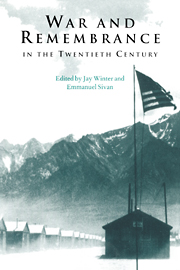Book contents
- Frontmatter
- Contents
- Preface
- Introduction
- 1 Setting the framework
- 2 Forms of kinship and remembrance in the aftermath of the Great War
- 3 War, death, and remembrance in Soviet Russia
- 4 Agents of memory: Spanish Civil War veterans and disabled soldiers
- 5 Children as war victims in postwar European cinema
- 6 From survivor to witness: voices from the Shoah
- 7 Landscapes of loss and remembrance: the case of Little Tokyo in Los Angeles
- 8 The Algerian War in French collective memory
- 9 Private pain and public remembrance in Israel
- 10 Personal narratives and commemoration
- 11 Against consolation: Walter Benjamin and the refusal to mourn
- Index
- Studies in the Social and Cultural History of Modern Warfare
Introduction
Published online by Cambridge University Press: 27 October 2009
- Frontmatter
- Contents
- Preface
- Introduction
- 1 Setting the framework
- 2 Forms of kinship and remembrance in the aftermath of the Great War
- 3 War, death, and remembrance in Soviet Russia
- 4 Agents of memory: Spanish Civil War veterans and disabled soldiers
- 5 Children as war victims in postwar European cinema
- 6 From survivor to witness: voices from the Shoah
- 7 Landscapes of loss and remembrance: the case of Little Tokyo in Los Angeles
- 8 The Algerian War in French collective memory
- 9 Private pain and public remembrance in Israel
- 10 Personal narratives and commemoration
- 11 Against consolation: Walter Benjamin and the refusal to mourn
- Index
- Studies in the Social and Cultural History of Modern Warfare
Summary
This book arose from the sense of unease the editors have felt over a number of years about weaknesses in the huge and rapidly growing historical literature on the subject of ‘collective memory’. It seems as if everyone is talking about this subject. The terms ‘memory’ and ‘collective memory’ appear with such frequency and ease that readers may be under the impression that there is a scholarly consensus about what these terms mean and how they may be used effectively in historical study.
Nothing could be further from the truth. There is much discussion, but very little agreement, as to whether or not there are meaningful links between individual cognitive psychological processes and the cultural representations and gestures of groups. How groups ‘remember’ – or even if they ‘remember’ – cannot be extrapolated simply from evidence on the ways individuals store and retrieve information or images. Furthermore, the word ‘memory’ has profoundly different shades of meaning in different languages. It should not be surprising, therefore, that historians frequently talk at cross purposes or in complete ignorance of each other's position in this field.
A good example of the ambiguity of much writing on collective memory is the work of Pierre Nora, the organizer and inspiration behind an influential, seven-volume collection of essays on sites of collective memory, Les lieux de mémoire, published between 1984 and 1992. His programmatic essay presents his point of view on collective memory in emphatic terms.
- Type
- Chapter
- Information
- War and Remembrance in the Twentieth Century , pp. 1 - 5Publisher: Cambridge University PressPrint publication year: 1999
- 2
- Cited by

